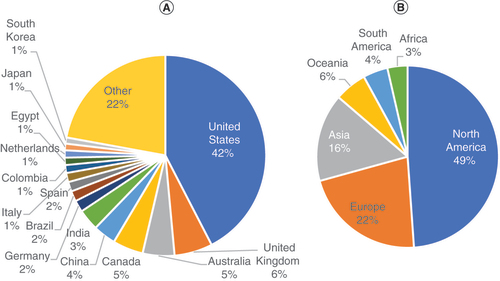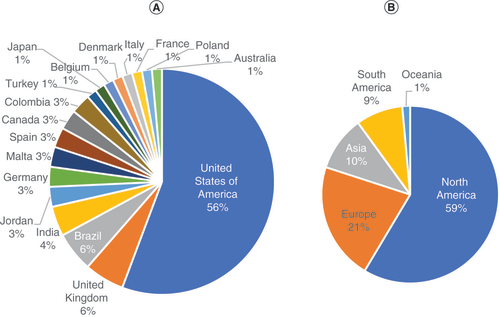Happy New Year to all of our readers, and welcome to the 12th volume of Pain Management. As with previous volumes, we would like to bring in the new year by highlighting some of the most successful articles of 2021, and to provide an overview of the performance of the journal over the past year.
However, before we jump into the data, we would first like to thank all of the authors, peer reviewers, and Editorial Advisory Board members who have contributed to and supported the journal over the last year. Many of our contributors are practising physicians as well as researchers, and the enormous pressures put on international medical systems by the Covid-19 pandemic have hardly relented since it began in 2020. Special thanks, therefore, go to everybody who has taken time out of their crowded schedule to write and review academic papers, in Pain Management as well as all of the other journals in the field, for the benefit and progression of pain medicine.
Content highlights
The top five most-accessed articles are shown in . We were pleased to see that a broad gamut of topics is represented in this table, from pharmacological pain management, to holistic treatment of osteoarthritis, to the potential effects of cannabis products on pain.
Table 1. Top Pain Management 2021 articles by readership (as of 12 October 2021).
Topping this list is an excellent review from Anand et al. [Citation1], which discussed the possible ‘entourage effects’ – defined as the potentiation of the activity of a compound by related but different compounds – of mixtures of cannabinoids. Although the authors agree with the near universal consensus that current evidence for the salutary effect of cannabinoids on pain is poor, they highlight the web of interactions of analogous cannabinoids (both exo- and endogenous) with receptor proteins that requires carefully designed trials to untangle.
This review was published in a context of accelerating legalization of cannabis products globally, as well as intense discussion and controversy. With the recent position statement of the International Association for the Study of Pain (IASP) Presidential Task Force on Cannabis and Cannabinoid Analgesia that did not endorse the general use of cannabinoids to treat pain [Citation6], it will be very interesting to see how research and discussion around this topic will develop over the coming year. The quality of the article, and energy of interest in this topic, are expressed in the high Altmetric score of 63, representing over one hundred tweets mentioning the article.
The next most-accessed article was a Commentary from Gulati et al. on opioid risk assessment tools, such as the Pain Medication questionnaire, Brief Risk questionnaire, and the Current Opioid Misuse Measure, and their applications in telemedicine [Citation2]. The transition of primary pain care from in-clinic to virtual remains a key concern of pain physicians during the Covid-19 pandemic, and we hope to see more research conducted on the optimization of telemedicine as in-person consultations remain restricted. Research in this area has important consequences for all communities during the pandemic, and furthermore may be of considerable utility to remote and low-resource communities once the threat of Covid-19 has passed.
The most-accessed Research Article reported the results of a Phase IIIb clinical trial comparing the safety and efficacy of intravenous meloxicam immediately following laparoscopic colorectal surgery versus a placebo [Citation4]. Freyer et al. reported that patients who received meloxicam exhibited lower opioid consumption, lower post-operative pain intensity, and lower resource utilization, with comparable safety profiles between both study groups.
Pain Management partners with the website NeuroCentral, an online resource that provides important news and opinions on the frontiers of neurology. The rapidly developing field of neuromodulation is of key interest to pain management professionals and neurologists, and to this end, NeuroCentral published a ‘Peek Behind the Paper’ interview [Citation7] with Krishnan Chakravarthy (University of California, CA, USA) about his 2021 paper in Pain Management on the StimRouter® for neurostimulation to treat chronic peripheral neuropathies [Citation8]. We hope to continue to collaborate more with NeuroCentral this year to disseminate our research and provide behind-the-scenes interviews with the authors of key papers. If you are interested in these digital enhancements for your research, please find further information on the Future Medicine website [Citation9].
Demographics
The journal readership demographics for 2021 are shown in .

We were pleased to see that total readership, in the form of full-text accesses on the Pain Management website, increased by nearly 30% in 2021 compared to the same period in 2020. The composition of our readers has remained roughly the same, with the same six countries (USA, United Kingdom, Australia, Canada, China, and India) making up 65% of our readers.
The ‘Other’ category aggregates 174 countries, all of whom make up less than 1% of the journal’s readership. Including the fifteen named countries in the pie-chart, this makes for a total of 189 countries.
The journal authorship demographics are displayed in .
Only accepted or in-progress submissions were included.

Submissions have been fairly constant this year compared to in the same period in 2020. The United States remains the most frequent submitting country, with the United Kingdom and Brazil producing the next-most submissions. However, we have experienced submissions from a greater range of countries in 2021 compared to previous years, with eighteen submitting countries versus ten in 2020. We hope to continue to attract and solicit high quality articles from an increasingly diverse range of countries over the next year, and to ensure we cover the full gamut of pain management concerns in different healthcare systems, economies, geographies, and cultures.
The coming year
Over the last year, Future Medicine has been pioneering the use of Plain Language Summaries of Publication. These are standalone, citeable summaries of published research written with the lay audience in mind and with the intention of increasing the accessibility of research to patients and their caregivers. Future Medicine has so far published ten Plain Language Summaries in four journals [Citation10], with interest growing across the publisher’s portfolio.
Patient advocacy and engagement is a critical factor in the appropriate delivery of pain care, particularly since pain is such a personal and individualized condition. Plain Language Summaries are an extremely useful tool in bridging the gap between the clinical literature and patient-directed resources such as pamphlets and healthcare websites, and improve the access of patients, their caregivers, and their general practitioners to the cutting edge of pain research.
We at Pain Management are therefore very excited to offer Plain Language Summary as a publication option in the journal, and we would like to encourage anybody with an interest in improving the accessibility of their research in this way to contact the journal editor. For more information, please see the plain language summaries website [Citation10].
Article outreach & online presence
You can keep track of Pain Management‘s activities, including article updates and the latest pain medicine news, by following our Twitter account (@fsgpmt) [Citation11].
Conclusion
We are pleased that 2021 has been a fruitful year for Pain Management, and we hope for the same success in 2022. However, as much as it is gratifying to see increasing readership of the journal, our aims will always be to provide an exemplary service our authors and to facilitate the publication of important research and opinion in support of the pain medicine community and pain patients. We hope that we have achieved this purpose in 2021, and that we will continue to do so in 2022.
Thank you again to all who contributed to Pain Management this year, whether in the form of submission, peer review, or membership of our Editorial Board, and extend thanks also to our readers. We look forward to working with you all again next year, and please do not hesitate to get in touch if you are interested in contributing to the journal.
Financial & competing interests disclosure
C Brooks is an employee of Future Medicine Ltd, publisher of Pain Management. The author has no other relevant affiliations or financial involvement with any organization or entity with a financial interest in or financial conflict with the subject matter or materials discussed in the manuscript apart from those disclosed.
No writing assistance was utilized in the production of this manuscript.
References
- Anand A , PacchettiB , AnandP , SodergrenMH. Cannabis-based medicines and pain: a review of potential synergistic and entourage effects. Pain Manag.11(4), 395–403 (2021).
- Ogilvie CB , JotwaniR , JoshiJ , GultaiA , MehtaN. Review of opioid risk assessment tools with the growing need for telemedicine. Pain Manag.11(2), 97–100 (2021).
- Fayet M , HagenM. Pain characteristics and biomarkers in treatment approaches for osteoarthritis pain. Pain Manag.11(1), 59–73 (2021).
- Silinsky JD , MarcetJE , AnupindiVRet al. Preoperative intravenous meloxicam for moderate-to-severe pain in the immediate post-operative period: a Phase IIIb randomized clinical trial in 55 patients undergoing primary open or laparoscopic colorectal surgery with bowel resection and/or anastomosis. Pain Manag.11(1), 9–21 (2021).
- Berkowitz RD , MackRJ , McCallumSW. Meloxicam for intravenous use: review of its clinical efficacy and safety for management of postoperative pain. Pain Manag.11(3), 249–258 (2021).
- IASP Presidential Task Force on Cannabis and Cannabinoid Analgesia . International Association for the Study of Pain Presidential Task Force on Cannabis and Cannabinoid Analgesia position statement. Pain162(Suppl. 1), S1–S2 (2021).
- A peek behind the paper – Krishnan Chakravarthy on the StimRouter® peripheral neuromodulation system for chronic pain management. www.neuro-central.com/a-peek-behind-the-paper-krishnan-chakravarthy-on-the-stimrouter-peripheral-neuromodulation-system-for-chronic-pain-management
- Regnier SM , ChenH , GabrielRA , ChakravarthyKC. A review of the StimRouter® peripheral neuromodulation system for chronic pain management. Pain Manag.11(3), 227–236.
- Future Medicine digital enhancements . https://www.tandfonline.com/authorguide/makingthemost
- Plain Language Summaries list of publications . www.plainlanguagesummaries.com/publication
- Pain Management Twitter profile. https://twitter.com/fsgpmt
